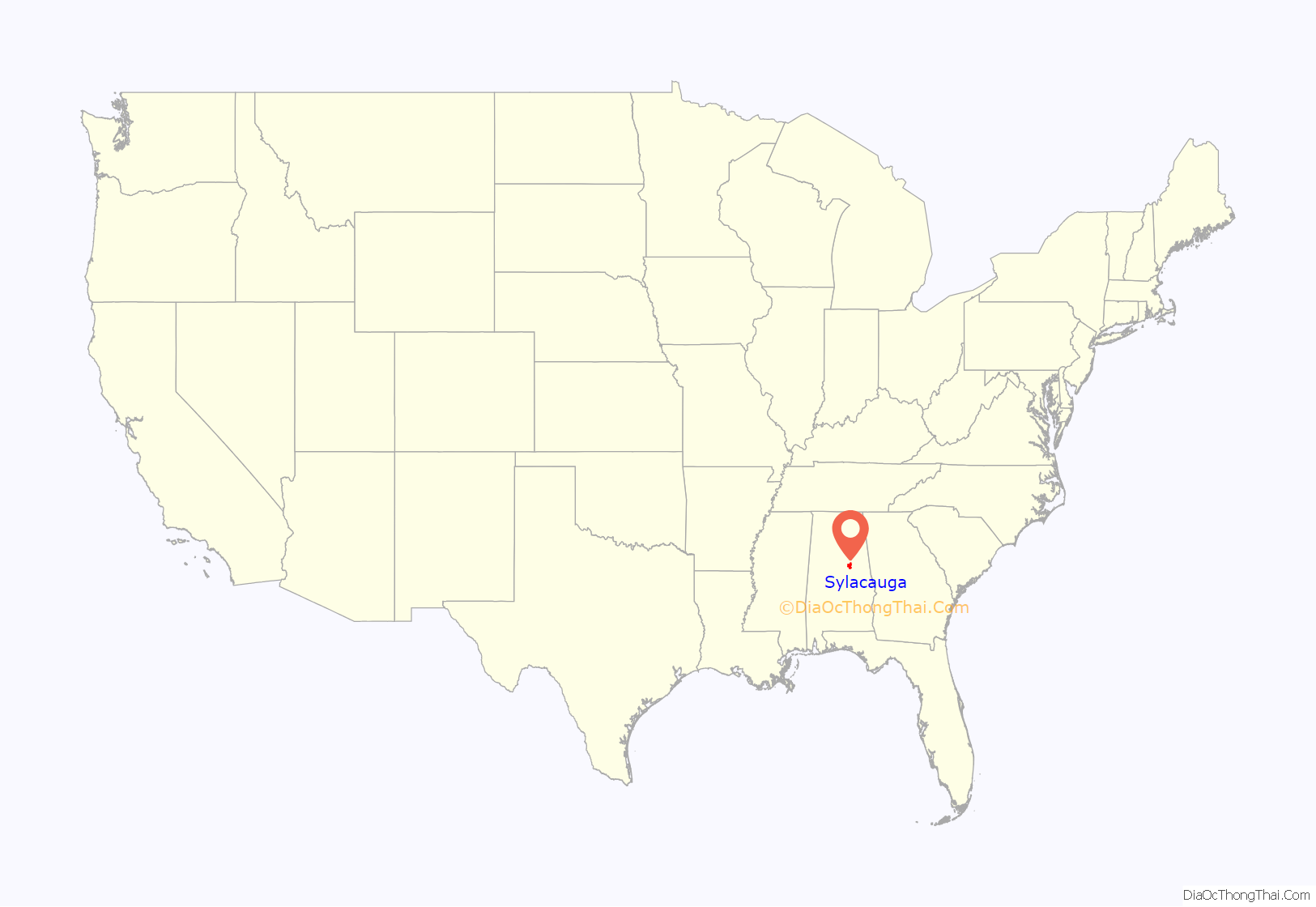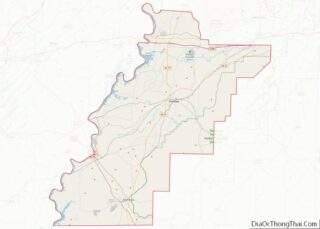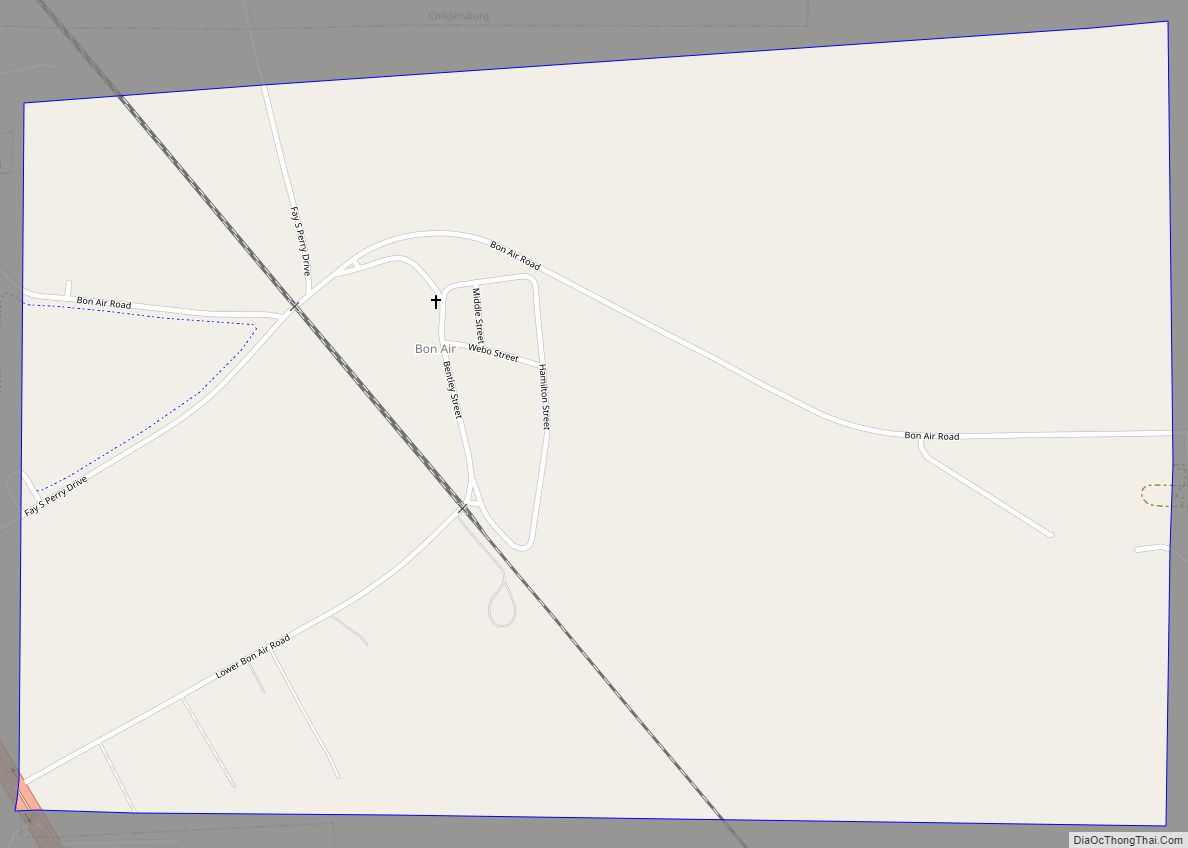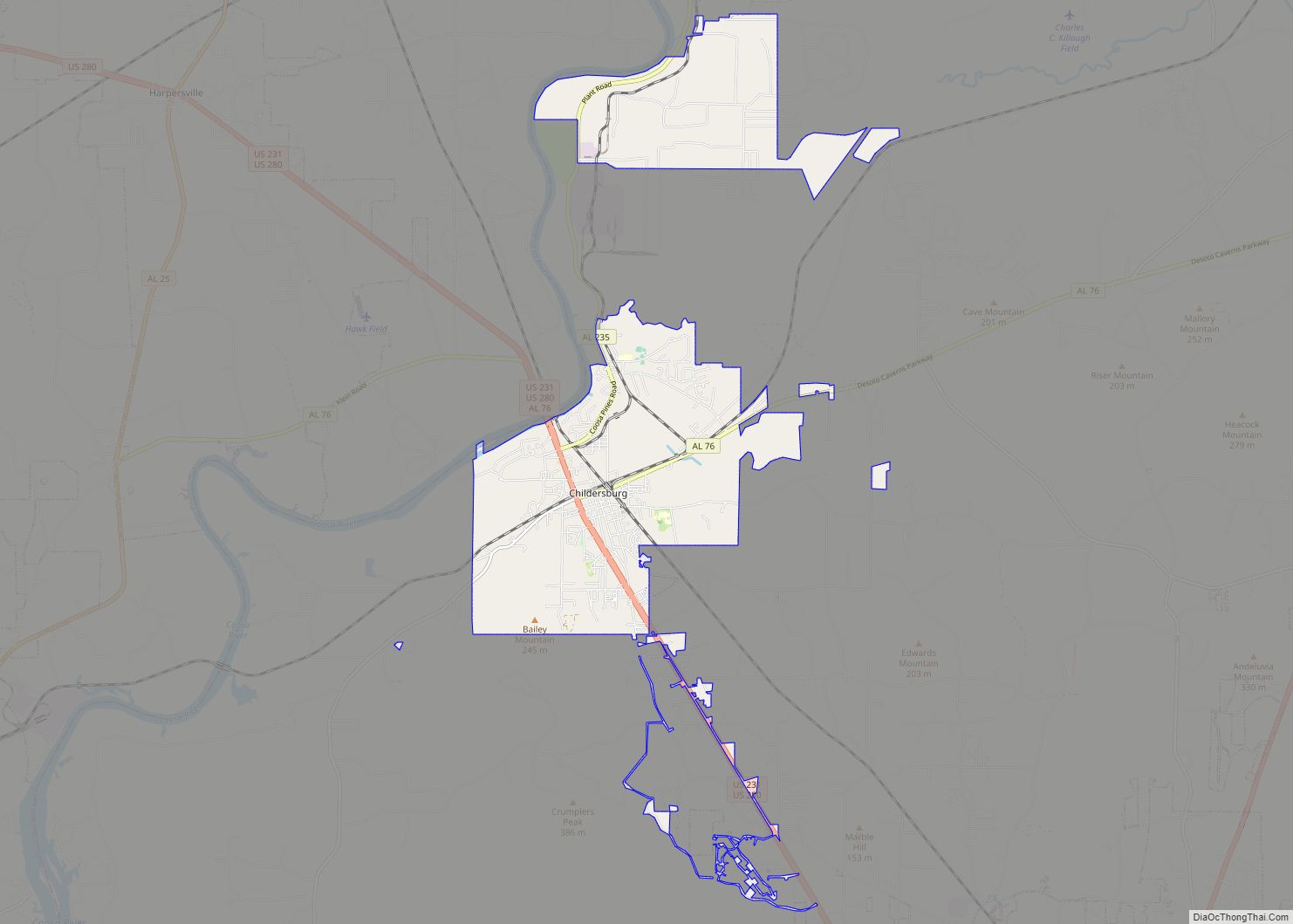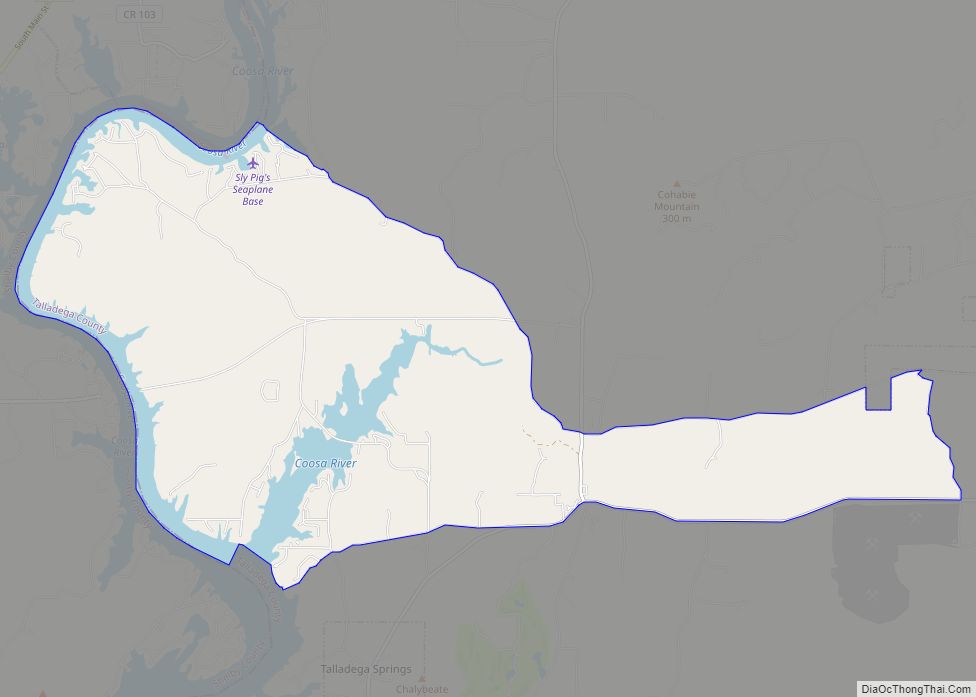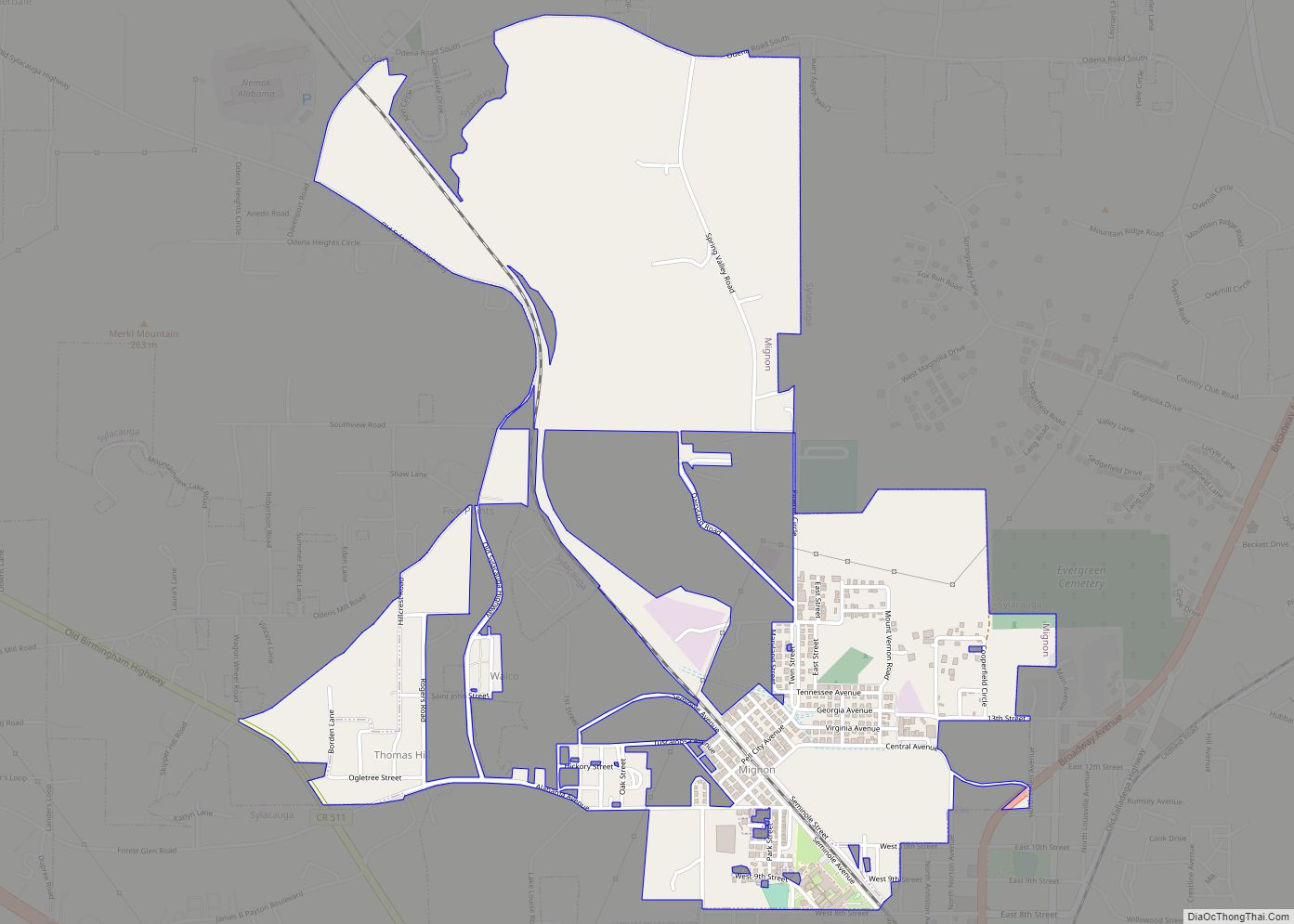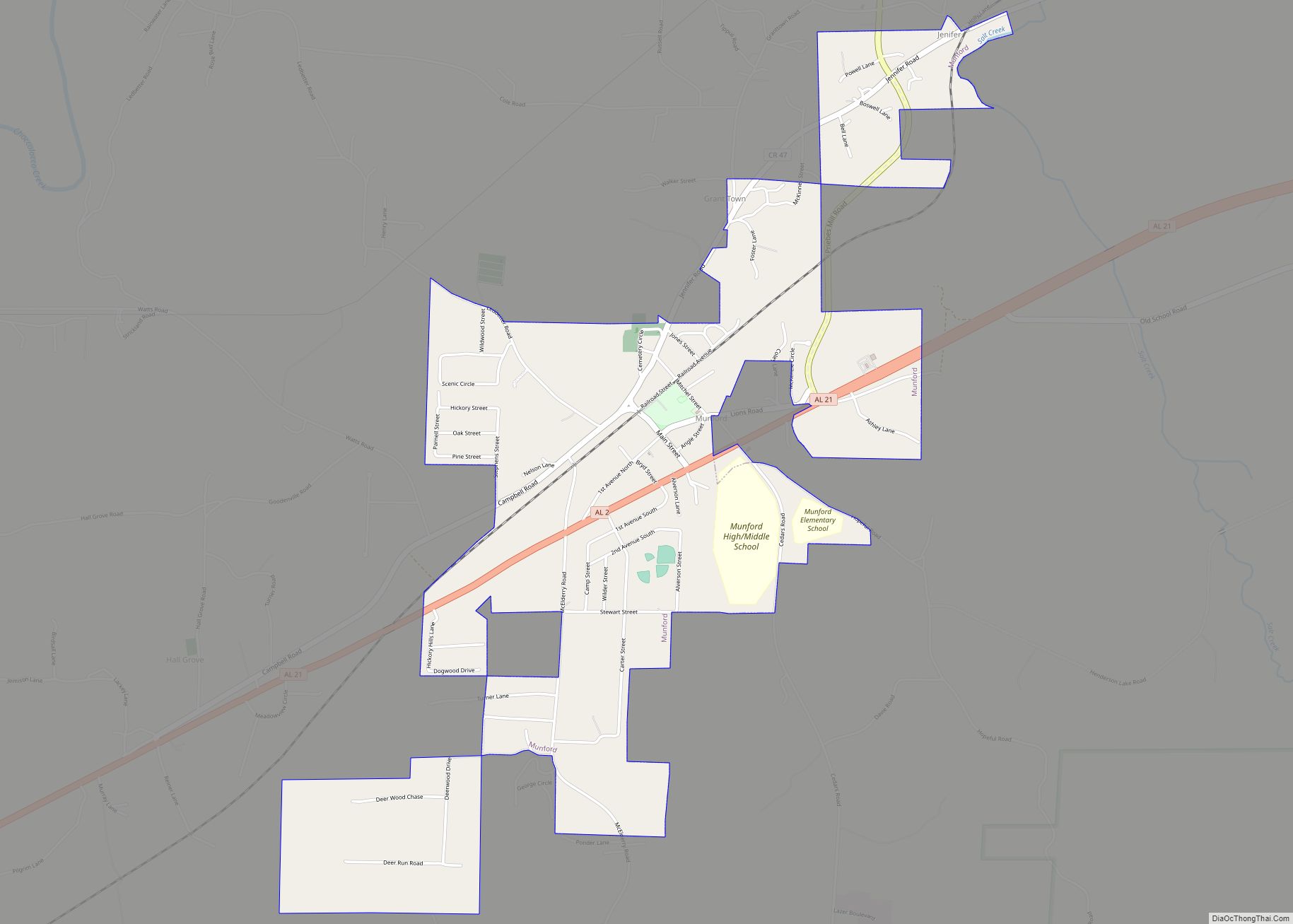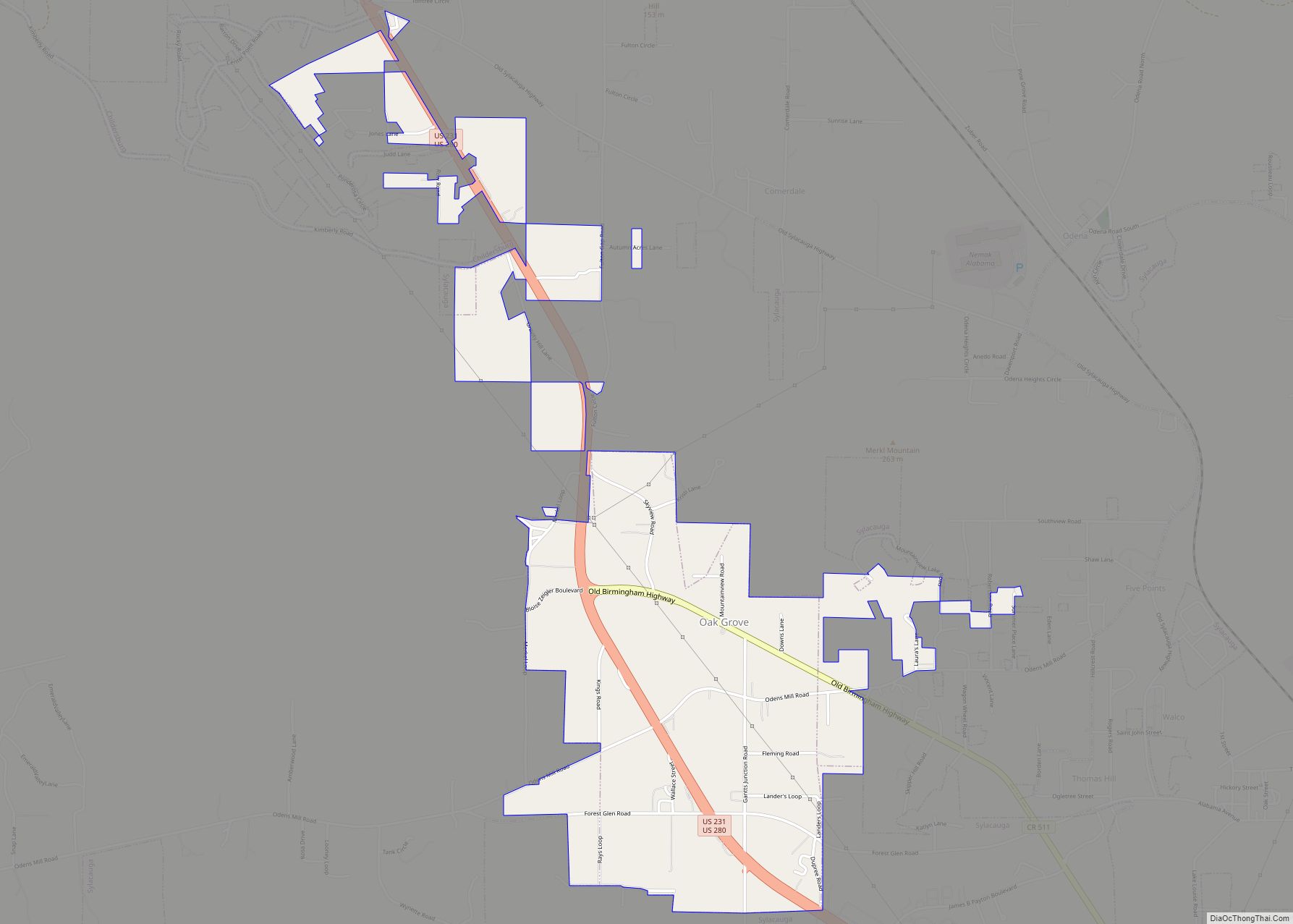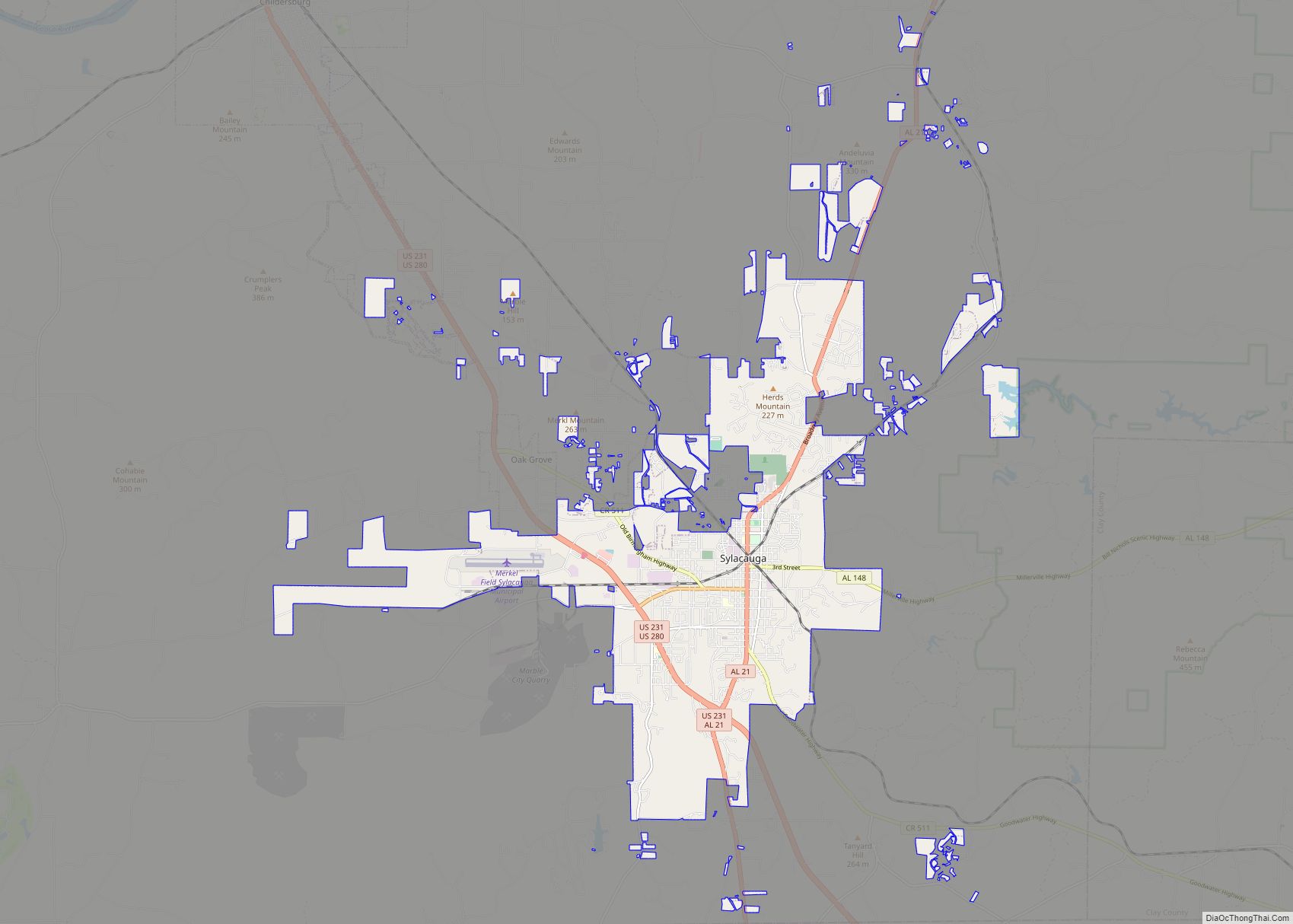Sylacauga is a city in Talladega County, Alabama, United States. At the 2020 census, the population was 12,578.
Sylacauga is known for its fine white marble bedrock. This was discovered shortly after settlers moved into the area and has been quarried ever since. The marble industry was the first recorded industry in the Sylacauga area.
Sylacauga is the site of the first documented case of an object from outer space hitting a person. On November 30, 1954, a 4 kg (9 lb) piece of what became known as the Hodges Fragment from the Sylacauga Meteorite crashed through the roof of an Oak Grove house, bounced off a radio, and badly bruised Ann Hodges, who was taking an afternoon nap.
Sylacauga is on the 2010 list of “100 Best Communities for Young People” by America’s Promise Alliance.
| Name: | Sylacauga city |
|---|---|
| LSAD Code: | 25 |
| LSAD Description: | city (suffix) |
| State: | Alabama |
| County: | Talladega County |
| Elevation: | 545 ft (166 m) |
| Total Area: | 20.42 sq mi (52.88 km²) |
| Land Area: | 20.25 sq mi (52.46 km²) |
| Water Area: | 0.16 sq mi (0.42 km²) |
| Total Population: | 12,578 |
| Population Density: | 621.01/sq mi (239.78/km²) |
| ZIP code: | 35150-35151 |
| Area code: | 256/938 |
| FIPS code: | 0174352 |
| GNISfeature ID: | 0160702 |
| Website: | www.cityofsylacauga.net |
Online Interactive Map
Click on ![]() to view map in "full screen" mode.
to view map in "full screen" mode.
Sylacauga location map. Where is Sylacauga city?
History
The first historical account of the area comes from de Soto’s chroniclers as his expedition traveled south along the east bank of the Coosa River in 1540, encountering the town of Talisi at the edges of the Mississippian-era chiefdoms of Coosa and Tuskaloosa. The inhabitants of the Coosa River Valley were later united as the confederacy of Creek people. Their later encounters with Spanish and French settlers had a significant influence on the history of Sylacauga.
Events that occurred among these three groups were partly responsible for the settlement of the village of Chalakagay in 1748 near modern Sylacauga by refugee Shawnee Indians, led by Peter Chartier. In 1759 Chalakagay was listed in the French territorial records as a town inhabited by 50 Shawnee warriors. Late in the summer of 1836 most of the remaining Native Americans in Alabama were rounded up and forcibly escorted west of the Mississippi River, by United States Army forces under the authorization of the Indian Removal Act. They were forced to cede their land claims in the Southeast to yield to development by European Americans.
The name Sy-la-cau-ga is derived from the Indian words Chalaka-ge, which mean “The Place of the Chalaka Tribe”. The city was first incorporated in 1838 as Syllacoga, and again in 1887 as Sylacauga.
Several important roads traversed the region as early as the 1830s. Numerous ferries connected communities on opposite sides of the rivers. In 1852, a plank road was built from Montgomery, the capital, to Winterboro, Alabama, passing through Sylacauga. The first railroad through Sylacauga was the Anniston and Atlantic Railroad, completed through here on December 1, 1886. In 1838, the first Sylacauga post office was established, with George Washington Stone as postmaster. He later served as Chief Justice of the Alabama Supreme Court.
The first newspaper, the Sylacauga Argus, started publication in 1887. The paper was printed and edited in Calera by H.G. McCall.
Sylacauga’s main thoroughfare is Broadway Avenue. The first building on this street was built in 1890 by the Smith Brothers.
Known as “The Marble City”, Sylacauga was developed on a solid deposit of what is claimed to be the finest marble in the world. Some of the most beautiful buildings in the country, such as the United States Supreme Court, the Al Jolson Shrine in California, the Woolworth building in Houston, Texas, and many others have been constructed and ornamented with Sylacauga marble.
Sylacauga is located slightly to the east of the geographical center of the state of Alabama in Talladega County. The city is roughly 51 miles (82 km) southeast of Birmingham, 63 miles (101 km) north of Montgomery, and 40 miles (64 km) southwest of Anniston, Alabama.
Marble industry
The first recorded discovery of marble was in 1820 by Dr. Edward Gantt, a physician who had accompanied General Andrew Jackson through the area in 1814. Even Gantt probably did not realize the extent of this calcium carbonate deposit. The deposit is part of the “Murphy Marble Belt”, extending 32 by 1.5 miles (51.5 by 2.4 km) by 400 feet (120 m) deep. It is the world’s largest commercial deposit of madre cream marble.
In the 1830s, several quarries were opened in Talladega County and perhaps one in neighboring Coosa County. Using the old Plank Road, the operators shipped marble throughout central Alabama. By 1906, New York interests had bought Gantt’s quarry from its Ocala, Florida investors. This site became the center of marble-working activity. An elite town developed in and around this property, later called the Alabama Marble Company.
By the start of the 20th century, Sylacauga quarries had an established reputation, and shipments were being made throughout the state. Although structural marble was being produced to some extent, a very lucrative use of marble was found in the steel industry. More and more of the Sylacauga deposits were being blasted and used for fluxing steel. Later dolomite replaced marble in this process. In spite of the approaching depression, the late 1920s and early 1930s were times of spectacular growth for Sylacauga’s marble industry.
Technology changed the course of the industry when electricity replaced steam. Countless small marble operations had sprung up throughout the years. Facing tough competition, many went out of business or were absorbed by the larger companies, Alabama and Moretti-Harrah. One such significant merger was in 1929 when the Madras Marble Company (formerly Sylacauga Marble Corporation) merged with Moretti-Harrah.
In 1935 the Moretti-Harrah Company was sold to B.F. Coggins of Atlanta and T.A. McGahey of Columbus, Mississippi. In 1944 Coggins sold the Sylacauga operation and Columbia Marble Company of North Carolina to McGahey. The Alabama Marble Company remained under its own management until 1963, when it merged with the Georgia Marble Company.
The reputation of Sylacauga marble producers was shown by use of their marble on numerous building projects throughout the nation. Alabama Marble Company supplied marble for the 19th-century projects in Washington, DC, the Washington Monument and Lincoln Memorial. Marble supplied for the Washington monument was so like its Italian counterpart, Carrara marble, that it was placed aside until a confirmation of its origin could be made. Moretti-Harrah, in a 3+1⁄2 year project shared with Gray-Knox Marble Company of Knoxville, supplied much of the marble for the U.S. Supreme Court building, including 36 massive interior columns measuring 22’ long x 3’4” in diameter.
Listing all the buildings that use this lustrous stone would be difficult. Other memorable projects are the Dime Savings Bank (New York), the Mercedes-Benz showroom (New York), the Chicago Post Office, the Alabama Archives Building, the Chrysler Mausoleum (New York), and the Al Jolson Shrine (California). Beautiful cream marble from Sylacauga can be found in hotels, offices, mausoleums, memorials and homes across the country.
Noted sculptor Gutzon Borglum, creator of the Mount Rushmore National Memorial, sculpted a masterpiece from Alabama marble – the bust of Abraham Lincoln. It is located in the rotunda of the nation’s Capitol. Borglum commented that the fine texture of Alabama marble enabled him to portray the expression of kindness on Lincoln’s face that he had never been able to do with any other stone.
By the 1940s endless uses for calcium products extracted from marble deposits became obvious. Calcium was needed for agricultural, pharmaceutical and paint products. Alabama Marble Company had already moved in this direction, having introduced its first Raymond Mill products for animal feed, insecticides, and joint cement materials in 1933. By-products were sold under the name of Alabama Calcium Products. By 1964, the company had completed one of the largest multi-product calcium carbonate plants in the United States, and in 1967 it closed its structural marble plant.
Moretti-Harrah chose to continue its structural finishing operations. With increasingly fast and updated precision machinery, it introduced new lines of tile, window sills, and other building products. In addition, Moretti-Harrah expanded operations to include calcium products, entering into a partnership with Thompson-Weinman and Company of Cartersville, Georgia, in 1944. In 1956, Thompson-Weinman expanded its own crushing operation in Sylacauga. Sylacauga Calcium Products was formed as a division of Moretti-Harrah.
Thompson, Weinman and Company remained privately owned until 1975, when it was purchased by Cyprus Mines Corporation. In 1979 Cyprus Mines was purchased by Standard Oil Company of Indiana, and it became a subsidiary of Amoco Minerals Company.
In 1983 an expansion project of its calcium carbonate facilities was conducted. The expansion involved the installation of additional grinding capacity and new mill facilities to enable increased production. Calcium carbonate, long used as the coating of paper, became an important filler as the paper industry converted from acid-based paper making systems to alkaline systems. In 1988 English China Clays (ECC) International purchased Moretti Harrah, and in 1989 ECC purchased Cyprus Thompson Weinman. Then, Georgia Marble Company purchased Cyprus Thompson Weinman.
In 1995, Imetal Group of Paris acquired the Georgia Marble Company, allowing this international company to strengthen its U.S. presence in the white pigments industry. Between 1994 and 1998, Imetal doubled in size; one-third through sales growth and two-thirds through acquisition. In 1999, Imetal acquired ECC. At that time the corporate name was changed to Imerys, to reflect a new minerals processing organization.
Sylacauga Road Map
Sylacauga city Satellite Map
Geography
Location
The city is located in southern Talladega County. Major highways that run through the city include US Routes 280 and 231, as well as Alabama State Route 21. US 280 runs northwest to southeast through the city, leading northwest (with US 231) 10 mi (16 km) to Childersburg and 47 mi (76 km) to Birmingham. US 280 runs southeast 26 mi (42 km) to Alexander City and US 231 runs south 21 mi (34 km) to Rockford. Alabama 21 runs northeast 21 mi (34 km) to the city of Talladega.
Climate
The climate in this area is characterized by hot, humid summers and generally mild to cool winters. According to the Köppen Climate Classification system, Sylacauga has a humid subtropical climate, abbreviated “Cfa” on climate maps.
See also
Map of Alabama State and its subdivision:- Autauga
- Baldwin
- Barbour
- Bibb
- Blount
- Bullock
- Butler
- Calhoun
- Chambers
- Cherokee
- Chilton
- Choctaw
- Clarke
- Clay
- Cleburne
- Coffee
- Colbert
- Conecuh
- Coosa
- Covington
- Crenshaw
- Cullman
- Dale
- Dallas
- De Kalb
- Elmore
- Escambia
- Etowah
- Fayette
- Franklin
- Geneva
- Greene
- Hale
- Henry
- Houston
- Jackson
- Jefferson
- Lamar
- Lauderdale
- Lawrence
- Lee
- Limestone
- Lowndes
- Macon
- Madison
- Marengo
- Marion
- Marshall
- Mobile
- Monroe
- Montgomery
- Morgan
- Perry
- Pickens
- Pike
- Randolph
- Russell
- Saint Clair
- Shelby
- Sumter
- Talladega
- Tallapoosa
- Tuscaloosa
- Walker
- Washington
- Wilcox
- Winston
- Alabama
- Alaska
- Arizona
- Arkansas
- California
- Colorado
- Connecticut
- Delaware
- District of Columbia
- Florida
- Georgia
- Hawaii
- Idaho
- Illinois
- Indiana
- Iowa
- Kansas
- Kentucky
- Louisiana
- Maine
- Maryland
- Massachusetts
- Michigan
- Minnesota
- Mississippi
- Missouri
- Montana
- Nebraska
- Nevada
- New Hampshire
- New Jersey
- New Mexico
- New York
- North Carolina
- North Dakota
- Ohio
- Oklahoma
- Oregon
- Pennsylvania
- Rhode Island
- South Carolina
- South Dakota
- Tennessee
- Texas
- Utah
- Vermont
- Virginia
- Washington
- West Virginia
- Wisconsin
- Wyoming
